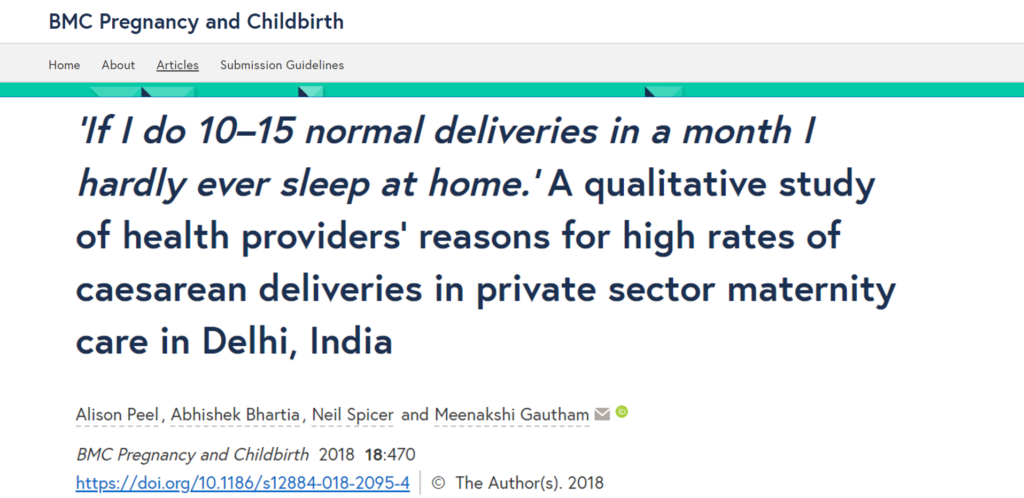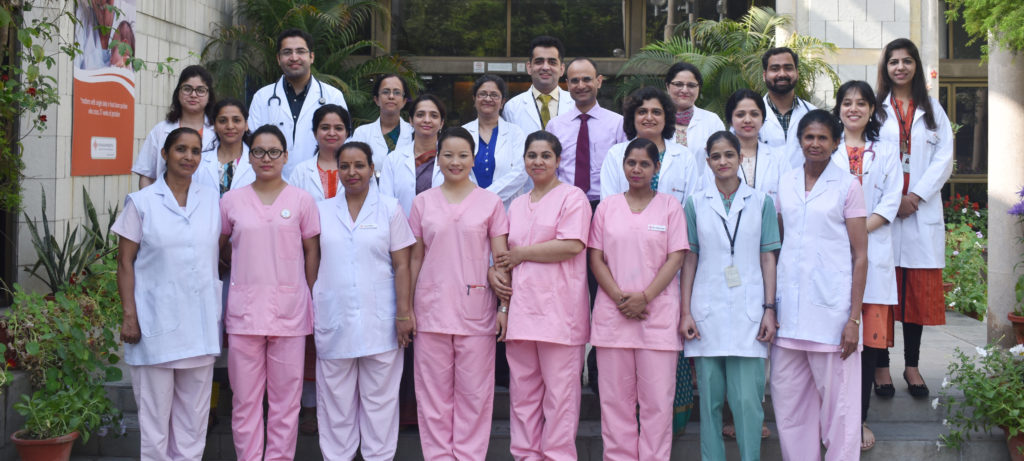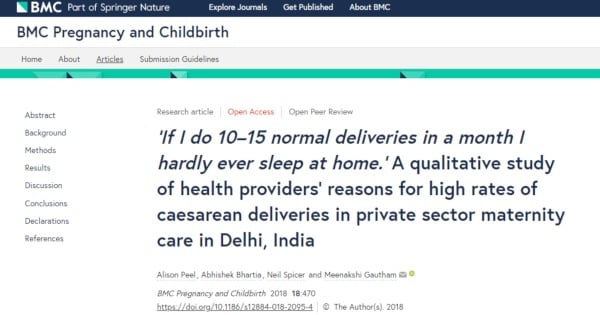The epidemic of cesarean sections in private hospitals of urban India has recently been getting increased attention. Doctors and hospitals have been accused of doing cesareans for financial gains. There has been a demand for requiring hospitals to display their cesarean rates3and one politician has called for ‘naming and shaming’ doctors who conduct cesareans only for money.
The cesarean problem of private hospitals is not new. A study conducted in Chennai in 1999 found a cesarean rate of 47%5. In our hospital we had a cesarean rate of 79% in 2001.
While it may be tempting for politicians and members of the public to seek regulation and punishment as a solution for the cesarean problem, without a deeper understanding we risk achieving little more than pushback from the obstetricians and their harassment. Understanding the perspective of the obstetricians and the wider healthcare community is critical if we are to identify the real barriers to lowering the cesarean rate.
It was with this objective that we collaborated with a postgraduate researcher from the London School of Hygiene and Tropical Medicine to conduct a study in which we interviewed 10 obstetricians, 2 pediatricians, a doula and a hospital chief executive for their perspectives on the reasons behind the caesarean epidemic in Delhi’s private hospitals.

Acceptance of the problem
Most respondents, including obstetricians, agreed that the cesarean rate was medically unjustifiable. Two obstetricians believed that the cesarean rate could be as high as 90% in some hospitals.
Time pressure
Time pressure on obstetricians emerged as one of the leading reasons for excessive cesareans. Given that normal deliveries can take upwards of 12 hours and can require an obstetrician’s presence at any time during the day or night, obstetricians liberally used cesarean sections to manage multiple professional and personal commitments.
“One normal delivery costs me at least a night, sometimes 2 nights. If I do 10-15 normal deliveries in a month I hardly ever sleep at home. If I do 15 caesareans I’m not home late for coffee.”
The culture of solo practice exacerbated time pressure as obstetricians could not rely on colleagues to share their work load. Some obstetricians had to contend with conducting an outpatient clinic while having women in labour at different hospitals.
Knowledge and confidence for continuing with labour
Obstetricians identified lack of clear practice guidelines by an Indian body and lack of awareness of newer evidence-based guidelines as other factors contributing to the high caesarean rate.
They also reported fearing legal action if something went wrong while trying for a normal delivery and saw cesareans as a “more comfortable and assured path…” Lacking a culture for shared practice, obstetricians felt pressured by being the sole decision maker.
Poor support system
Obstetricians identified lack of midwifery skills among the nurses as a factor. This meant that they had to bear the burden of responsibility throughout the time that a woman was in labour.
It’s not about the money!
Contrary to popular belief, obstetricians vehemently rejected the assertion that financial incentives drive the high caesarean rate.
“No no no no no! …the charges [fees charged by
doctors] for caesarean and normal delivery are almost
at one. So that is never a reason.”
Cesareans on demand
Obstetricians reported requests for scheduled deliveries and pressure from family members during labour for conducting a cesarean. Rectifying such a situation was challenging for them, again because of time pressure.
“The easiest approach is that I do what the patient is
saying…the more I try to explain the more time is
used…I might as well give her a date for caesarean in
5 minutes”
From a 79% cesarean rate down to 18%
When we discovered our 79% caesarean rate in 2001, we acknowledged that this was inconsistent with our mission of delivering high quality care and committed ourselves to lowering the rate.
We began by regularly auditing our data and sharing the caesarean section rate of each consultant within the unit.
We took steps to alleviate time pressure on obstetricians by creating a unit of full-time consultants.
We reduced uncertainty in decision-making by adopting practice guidelines issued by the Royal College of Obstetricians and Gynecologists (suitably modified for our setting) and promoting a culture in which consultants found it easy to seek second opinions.
We invested in recruitment and training of nurses and junior doctors to give confidence to consultants that women could safely labour even in their absence.
We trained childbirth educators and started antenatal classes to prepare women for a normal delivery.
Over time our consultants organised themselves as a group practice in which they conducted deliveries by rotation.
We also had one consultant emerge as a clinical leader who first lowered her own cesarean rate and then helped the unit improve.

These changes produced results that exceeded our expectations. The caesarean rate in our unit progressively fell to 18% by 2016. Even better, our first-birth low-risk* moms had a 88% vaginal delivery rate!
Spreading improvement
We were able to reduce the caesarean rate at Sitaram Bhartia Hospital because we addressed many of the barriers that have been identified by private obstetricians in this study.
The big question is how other hospitals and consultants may use the findings of our study, and perhaps our example, to improve. In the absence of any systematic efforts for lowering cesarean rates in India, and few success stories, one can only speculate on how best to proceed.
My belief is that we should start by requiring all hospitals to report their cesarean rates publicly. The rproposal by the health ministry requiring such disclosure as a condition for renewing empanelment with the Central Government Health Scheme, if implemented, would be a step in the right direction.
However, the government must avoid using high caesarean rates to attack obstetricians and recognise that consultants themselves are caught in a system that leaves them unsupported and expects them to be available 24 x 7. Instead the government should focus on improving midwifery skills of our nurses, engaging with professional societies such as FOGSI to provide leadership on this issue, and educating the public about the benefits of a normal delivery.
After all people become doctors to serve, not conduct unnecessary surgeries for convenience or profit.
Come in for an in-person consultation with our team of senior gynecologists in South Delhi. Please call on +91 9871001458 to schedule your appointment.

